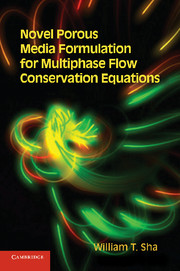Book contents
- Frontmatter
- Contents
- Figures and Table
- Foreword
- Foreword
- Foreword
- Nomenclature
- Preface
- Acknowledgments
- 1 Introduction
- 2 Averaging relations
- 3 Phasic conservation equations and interfacial balance equations
- 4 Local volume-averaged conservation equations and interfacial balance equations
- 5 Time averaging of local volume-averaged conservation equations or time-volume-averaged conservation equations and interfacial balance equations
- 6 Time averaging in relation to local volume averaging and time-volume averaging versus volume-time averaging
- 7 Novel porous media formulation for single phase and single phase with multicomponent applications
- 8 Discussion and concluding remarks
- Appendix A
- Appendix B
- Appendix C
- Appendix D
- References
- Index
Appendix A
Published online by Cambridge University Press: 07 October 2011
- Frontmatter
- Contents
- Figures and Table
- Foreword
- Foreword
- Foreword
- Nomenclature
- Preface
- Acknowledgments
- 1 Introduction
- 2 Averaging relations
- 3 Phasic conservation equations and interfacial balance equations
- 4 Local volume-averaged conservation equations and interfacial balance equations
- 5 Time averaging of local volume-averaged conservation equations or time-volume-averaged conservation equations and interfacial balance equations
- 6 Time averaging in relation to local volume averaging and time-volume averaging versus volume-time averaging
- 7 Novel porous media formulation for single phase and single phase with multicomponent applications
- 8 Discussion and concluding remarks
- Appendix A
- Appendix B
- Appendix C
- Appendix D
- References
- Index
Summary
A staggered-grid computational system is widely used in numerical analysis. A family of COMMIX codes is no exception; the codes greatly benefited by using this system. In this system, all dependent nonflow variables (pressure, temperature, density, total energy, enthalpy, internal energy, mass fraction of phases, turbulent transport quantities, thermal physical properties, etc.) are calculated for the computational cell center (I, J, K) in three-dimensional orthogonal coordinates, and all flow variables (velocity components) are calculated for the surfaces of the computational cell (I ± 1/2, J ± 1/2, K ± 1/2). The computational cell is defined by the locations of cell volume faces, and a grid point is placed in the geometric center of each cell volume; cell sizes can be nonuniform. This type of construction of computational system is shown in .
Consider the control volume for a nonflow variable shown in . It is constructed around a grid point 0, which has grid points 1 (i − 1) and 2 (i + 1) as its west and east neighbors, 3 (j − 1) and 4 (j + 1) as its front and rear neighbors, and 5 (k − 1) and 6 (k + 1) as its south and north neighbors.
- Type
- Chapter
- Information
- Publisher: Cambridge University PressPrint publication year: 2011



